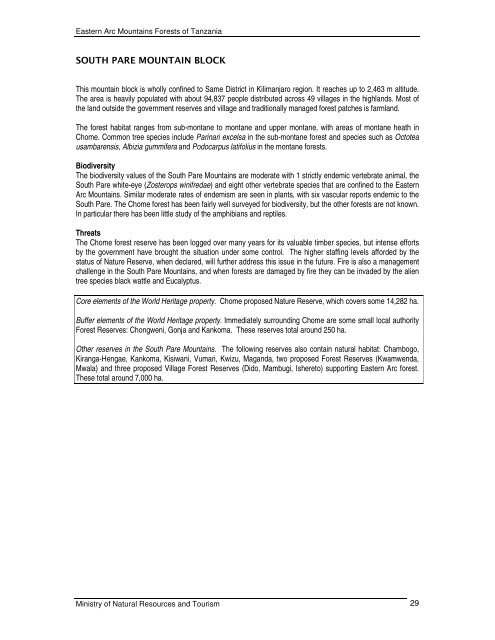eastern arc mountains forests of tanzania - Campaign for the ...
eastern arc mountains forests of tanzania - Campaign for the ...
eastern arc mountains forests of tanzania - Campaign for the ...
Create successful ePaper yourself
Turn your PDF publications into a flip-book with our unique Google optimized e-Paper software.
Eastern Arc Mountains Forests <strong>of</strong> Tanzania<br />
SOUTH PARE MOUNTAIN BLOCK<br />
This mountain block is wholly confined to Same District in Kilimanjaro region. It reaches up to 2,463 m altitude.<br />
The area is heavily populated with about 94,837 people distributed across 49 villages in <strong>the</strong> highlands. Most <strong>of</strong><br />
<strong>the</strong> land outside <strong>the</strong> government reserves and village and traditionally managed <strong>for</strong>est patches is farmland.<br />
The <strong>for</strong>est habitat ranges from sub-montane to montane and upper montane, with areas <strong>of</strong> montane heath in<br />
Chome. Common tree species include Parinari excelsa in <strong>the</strong> sub-montane <strong>for</strong>est and species such as Octotea<br />
usambarensis, Albizia gummifera and Podocarpus latifolius in <strong>the</strong> montane <strong><strong>for</strong>ests</strong>.<br />
Biodiversity<br />
The biodiversity values <strong>of</strong> <strong>the</strong> South Pare Mountains are moderate with 1 strictly endemic vertebrate animal, <strong>the</strong><br />
South Pare white-eye (Zosterops winifredae) and eight o<strong>the</strong>r vertebrate species that are confined to <strong>the</strong> Eastern<br />
Arc Mountains. Similar moderate rates <strong>of</strong> endemism are seen in plants, with six vascular reports endemic to <strong>the</strong><br />
South Pare. The Chome <strong>for</strong>est has been fairly well surveyed <strong>for</strong> biodiversity, but <strong>the</strong> o<strong>the</strong>r <strong><strong>for</strong>ests</strong> are not known.<br />
In particular <strong>the</strong>re has been little study <strong>of</strong> <strong>the</strong> amphibians and reptiles.<br />
Threats<br />
The Chome <strong>for</strong>est reserve has been logged over many years <strong>for</strong> its valuable timber species, but intense ef<strong>for</strong>ts<br />
by <strong>the</strong> government have brought <strong>the</strong> situation under some control. The higher staffing levels af<strong>for</strong>ded by <strong>the</strong><br />
status <strong>of</strong> Nature Reserve, when declared, will fur<strong>the</strong>r address this issue in <strong>the</strong> future. Fire is also a management<br />
challenge in <strong>the</strong> South Pare Mountains, and when <strong><strong>for</strong>ests</strong> are damaged by fire <strong>the</strong>y can be invaded by <strong>the</strong> alien<br />
tree species black wattle and Eucalyptus.<br />
Core elements <strong>of</strong> <strong>the</strong> World Heritage property. Chome proposed Nature Reserve, which covers some 14,282 ha.<br />
Buffer elements <strong>of</strong> <strong>the</strong> World Heritage property. Immediately surrounding Chome are some small local authority<br />
Forest Reserves: Chongweni, Gonja and Kankoma. These reserves total around 250 ha.<br />
O<strong>the</strong>r reserves in <strong>the</strong> South Pare Mountains. The following reserves also contain natural habitat: Chambogo,<br />
Kiranga-Hengae, Kankoma, Kisiwani, Vumari, Kwizu, Maganda, two proposed Forest Reserves (Kwamwenda,<br />
Mwala) and three proposed Village Forest Reserves (Dido, Mambugi, Ishereto) supporting Eastern Arc <strong>for</strong>est.<br />
These total around 7,000 ha.<br />
Ministry <strong>of</strong> Natural Resources and Tourism 29


